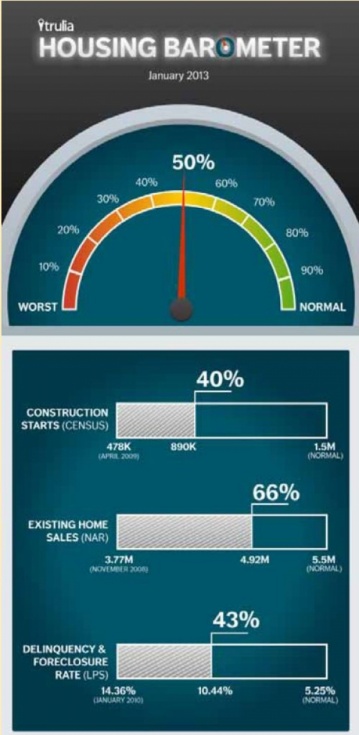
Each month, Trulia’s Housing Barometer shows how quickly the housing market is moving back to “normal.” The chart summarizes three key housing market indicators: construction starts (Census), existing home sales (NAR), and the delinquencyplus-foreclosure rate (LPS First Look).
For each indicator, we compare this month’s data to how bad the numbers got at their worst and to their pre-bubble “normal” levels.
In January 2013, construction starts slid, while home sales and the delinquency foreclosure rate both improved slightly relative to December.
Construction starts fell monthly, but were still up sharply year-over-year. Starts were at an 890,000 annualized rate, down 8.5% month-over-month but up 24% year-over-year. The month-over-month decline was relative to a December spike in multifamily housing starts, which tend to be volatile. January starts were at their second-highest level since July 2008, and single-family housing starts were at their highest level since that same month. Furthermore, residential construction employment was up 2.6% year-over-year in January – outpacing employment overall, which rose 1.5%. Construction starts are now 40% of the way back to normal.
Existing home sales edged up. Sales rose slightly to 4.92 million in January from 4.90 million in December. Year-over-year, sales were up 9%. But the mix of sales is shifting from “distressed” sales — foreclosures and short sales — to “conventional” home sales.
Excluding distressed sales, conventional home sales were up 29% year-overyear in January. Overall, existing home sales are 66% back to normal.
The delinquency foreclosure rate improved. After holding nearly steady for three months, the share of mortgages in delinquency or foreclosure fell in January to 10.44%, from 10.61% in December. The January rate is the lowest level since December 2008. The combined delinquency fore closure rate is 43% back to normal.
Averaging these three backto-normal percentages together, the housing market is now 50% of the way back to normal, down from 52% in December. That’s the first setback since June. Cause for alarm? No: the Housing Barometer reached 52% in December thanks to what looks like a t e m p o r a r y s p i k e i n multifamily housing starts. Even with this backward step in January, 50% back to normal represents steady progress. But January’s figures are a reminder that housing indicators often have monthly swings, and the longer-term trend is a better guide to the shape of the housing recovery.






















